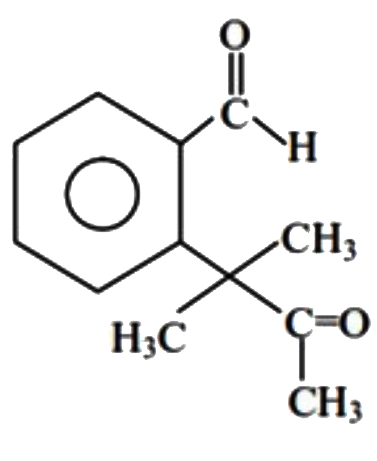C3H6O(A)↓Gives positiveTollen's testPhCHO−−−−−→OH−/ΔB
Product B is :
Ph−CH=C | CH3−CH3

Ph−CH3| C =CH−Ph
Ph−CH=C | CH3−CHO
The correct Answer is:D
To solve the problem, we need to determine the structure of product B formed when the compound C3H6O (which is likely an aldehyde or a ketone) reacts with benzaldehyde (PhCHO) in the presence of a base and heat.
1. Identify the Reactant (A):
- The compound C3H6O can be either an aldehyde or a ketone. Given that it gives a positive Tollen's test, it is likely an aldehyde. The possible structure for C3H6O is propanal (CH3CH2CHO).
2. Understanding Tollen's Test:
- Tollen's test is used to identify aldehydes. Aldehydes are oxidized to carboxylic acids, and in this case, since we have a positive Tollen's test, we can confirm that A is indeed an aldehyde.
3. Reaction with Benzaldehyde (PhCHO):
- In the presence of a base (OH^-) and heat, the aldehyde (propanal) will undergo a reaction with benzaldehyde. This is likely an aldol condensation reaction.
4. Mechanism of the Reaction:
- The base will deprotonate the aldehyde (propanal), generating an enolate ion. This enolate ion will then attack the electrophilic carbon of benzaldehyde (PhCHO).
- The reaction can be summarized as follows:
- Deprotonation of propanal to form the enolate ion.
- Nucleophilic attack of the enolate ion on the carbonyl carbon of benzaldehyde.
5. Formation of the Intermediate:
- After the nucleophilic attack, we will have a β-hydroxy aldehyde as an intermediate. The structure will contain the phenyl group from benzaldehyde and the propyl group from propanal.
6. Dehydration Step:
- Upon heating, the β-hydroxy aldehyde will undergo dehydration (loss of water) to form an α,β-unsaturated aldehyde. This will result in the formation of a double bond between the α and β carbons.
7. Final Product (B):
- The final product B will be an α,β-unsaturated aldehyde with the structure:
- Ph-CH=CH-CHO (where Ph represents the phenyl group).
Conclusion:
The structure of product B is an α,β-unsaturated aldehyde formed from the reaction of propanal with benzaldehyde in a basic medium.
- The compound C3H6O can be either an aldehyde or a ketone. Given that it gives a positive Tollen's test, it is likely an aldehyde. The possible structure for C3H6O is propanal (CH3CH2CHO).
- Tollen's test is used to identify aldehydes. Aldehydes are oxidized to carboxylic acids, and in this case, since we have a positive Tollen's test, we can confirm that A is indeed an aldehyde.
- In the presence of a base (OH^-) and heat, the aldehyde (propanal) will undergo a reaction with benzaldehyde. This is likely an aldol condensation reaction.
- The base will deprotonate the aldehyde (propanal), generating an enolate ion. This enolate ion will then attack the electrophilic carbon of benzaldehyde (PhCHO).
- The reaction can be summarized as follows:
- Deprotonation of propanal to form the enolate ion.
- Nucleophilic attack of the enolate ion on the carbonyl carbon of benzaldehyde.
- After the nucleophilic attack, we will have a β-hydroxy aldehyde as an intermediate. The structure will contain the phenyl group from benzaldehyde and the propyl group from propanal.
- Upon heating, the β-hydroxy aldehyde will undergo dehydration (loss of water) to form an α,β-unsaturated aldehyde. This will result in the formation of a double bond between the α and β carbons.
- The final product B will be an α,β-unsaturated aldehyde with the structure:
- Ph-CH=CH-CHO (where Ph represents the phenyl group).
The structure of product B is an α,β-unsaturated aldehyde formed from the reaction of propanal with benzaldehyde in a basic medium.
Similar Questions
Knowledge Check
- Question 1 - Select One
CH3−CH3∣C∣CH3−C∣BrH3Major product (A) is CH3−EtoH−−→Δ(A)
A B
B C
C D
D
- Question 2 - Select One
H3C−CH3∣C∣CH3−H+CCl4R2O2−−→hvProduct :
AH3C−CH3∣C∣CH3−ClBCHCl3CBoth (a) and (b)DNone of these
Identify (A) in the following reaction sequence
AGives Positiveiodoform test(i) CH3MgBr−−−−−−−−−−−→(ii) H+,H2O(iii) Conc. H2SO4/Δ(B)Oy/Zn,H2O−−−−−−−→ View Solution
View SolutionPh−OH∣C∣Me−Me∣C∣I−PhAgNO3−−−→Δ? Major product is
View SolutionPhCOOMe(A)(i)NH2OH−−−−−−−−−→(ii)ӨOH(iii)EtOH(B)
Product (B) is :View SolutionIn the given reaction the products is :
CH3−CH2−C∣∣O−OCH3+CH3−C∣∣O−OCH3(1)CH3OΘNa+−−−−−−−−−−→(2)CH3OHoversert(H2O)−−→Δ productView SolutionCH3−C∣∣O−H(1 e.q)+H−C∣∣O−HExcessOH−−−→ product
View SolutionCH2OH∣ C=O∣ (CHOH)3∣ CH2OHNaBH4−−−−→A+B
Fructose
The product A and B in the a above reaction are notView Solution


